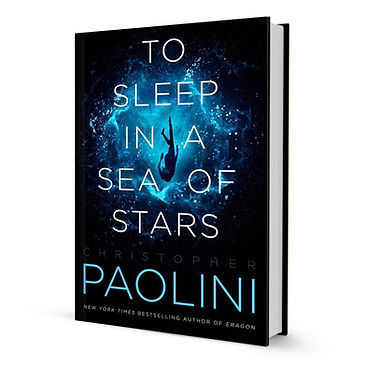

To Sleep in a Sea of Stars
by Christopher Paolini
Tor
"To Sleep in a Sea of Stars" is the first foray into Science Fiction by Christopher Paolini, the award-winning author of the "Eragon" saga and the youngest-ever author of a bestselling series (according to the Guinness Book of Records). It is a hefty 880-page doorstep of a book which I first saw balanced precariously on the shelf of the celebrated Foyles bookshop on Charing Cross Road before I gave it a home.
Typical of a successful writer of fantasy fiction, Paolini has worked out some pretty comprehensive background lore for the story. The book features a timeline from 2025, commencing with the construction of the first space elevator, stretching to 2258 when the story is set. There are also 3D maps of the local stellar neighbourhood showing humanity's advancement throughout the nearby star systems, a handy glossary, and lengthy appendices for Paolini's take on ship-based space combat and his fictional "Markov" FTL (Faster-than-Light) space travel technology.
You might expect a novel of this magnitude to have a myriad of different characters and numerous diverse and twisting story arcs that all come together at completion. Far from it. Instead, the narrative resolutely follows the main protagonist like an obedient lapdog and presents events in a strict chronological order without deviation except for a few "dream sequences" here and there.
Kira Navárez, a young xenobiologist is working for the Lapsang Corporation on the exomoon "Adrasteia" (Adra for short) an Earth-sized body in the Sigma Draconis star system. Adra is being terraformed ready for colonisation and Kira dreams of starting a new life there with her fiancé, Alan. Before that, there is just one last job to do - investigate some "organic material" that a survey drone identified before it crashed.
At the crash site, she discovers a strange rock formation and falls into an artificial cavern below with a strange basin mounted on a pedestal at its centre. In the basin is some swirling dust which starts pouring out of the receptacle, down the pedestal, and onto her foot. She loses consciousness as this alien material creeps all over her body until she is completely covered. When she comes around back at her outpost she finds herself covered in a layer of glossy, fibrous material like a skinsuit.
She has become host to a semi-organic alien symbiote which she calls "the Xeno". This entity possesses a rudimentary awareness and causes Kira to attack her colleagues and kill her fiance. Identifying the Xeno as a threat, the authorities (in this case, the "United Military Command" (UMC) of the "League of Worlds") quarantine the whole star system and engage in a series of increasingly forceful and fruitless attempts to remove it.
It is no coincidence that a few weeks after the discovery of the Xeno, humankind is attacked by the Wranaui (or "Jellies" as the UMC calls them), an alien race having the appearance of cephalopod molluscs that communicate by scent using language heavy with aquatic terminology and analogies. Either the Jellies had been watching the moon or a signal had gone out from the ruins when Navárez fell into them...
Kira has to figure out how to deal with the Wranaui threat and later on, "The Corrupted", another group of alien entities with a disturbing origin that join the fray. This is done whilst she strives to understand the Xeno, learn its purpose and how to master the amazing abilities it grants her. This brings me to one of the main criticisms I have about this book, and that is that the Xeno turns Kira into a "superhero-type" character seemingly obtaining new and more powerful abilities "out of a hat" whenever the story demands it. From the start, it makes her virtually impervious to attack and allows her to survive in the vacuum of space. Eventually, she learns that the Xeno can even manipulate and reconstruct matter at will and in an extemporaneous manner. The drama of a story is always lessened when the main protagonist appears capable of dealing with their trials and tribulations without much corresponding peril.
The main gripe, however, is that the book is just too long. The single, linear narrative is short on events, character development and interesting divergencies to merit its (almost) 900 pages. In fact, some sub-chapters could be omitted entirely without any detrimental effect on the plot at all. The action sequences are exciting and impactful when they arrive but these are few and far between, especially in the first two-thirds of the book. Finally, when the story has approached what seems a rather satisfying and logical conclusion, matters are thrown back up into the air and the book trundles on for another twenty pages. You could say that lays the ground for its sequels but otherwise, the extended ending comes across as unnecessary.
Paolini has obviously put a lot of effort into this sizeable feat of imagination and it has some entertaining sequences within it but not sufficient to encourage a slog through any future doorsteps in this "Fractalverse" series. It may prove a better fit for an episodic script format in the TV series that is rumoured to be in production for Disney+.
Rating
Christopher Paolini published his first novel, Eragon, in 2003 at the age of nineteen granting him a place in the Guinness Book of Records as the youngest author of a bestselling series. Eragon and its three sequels in his "Inheritance Cycle" have sold nearly 40 million copies worldwide. To Sleep in a Sea of Stars won the 2020 Goodreads Choice Award for Best Science Fiction Novel. In August 2022, Paolini announced that the book was being adapted as a television show and that writing had already begun on the scripts.


